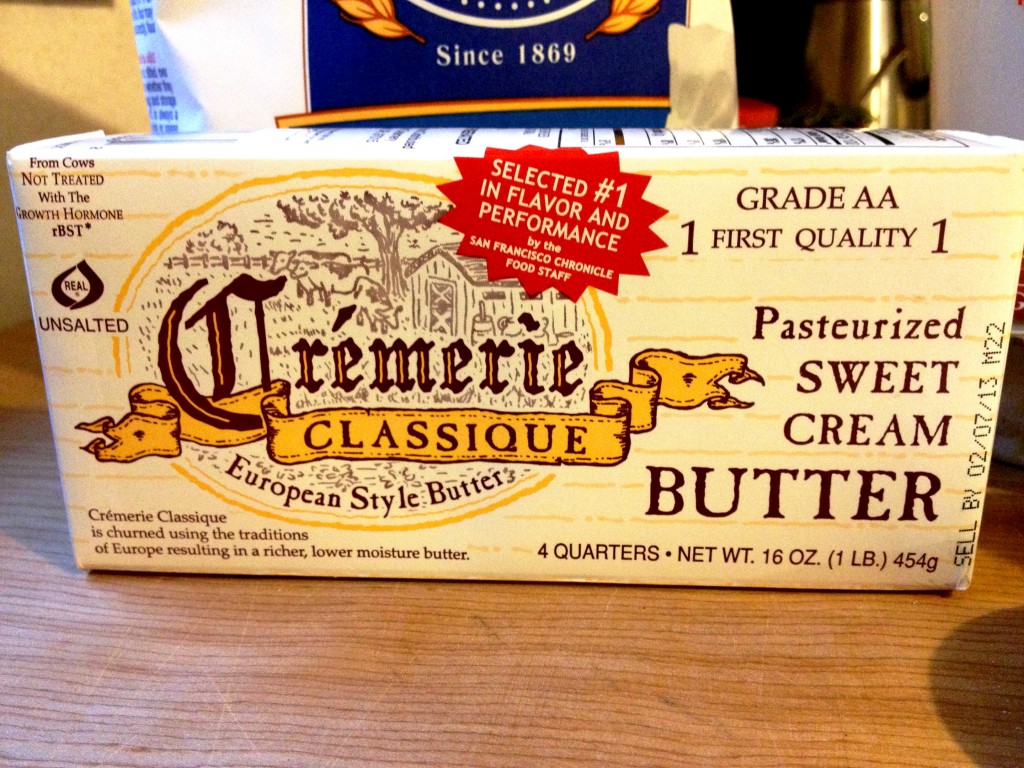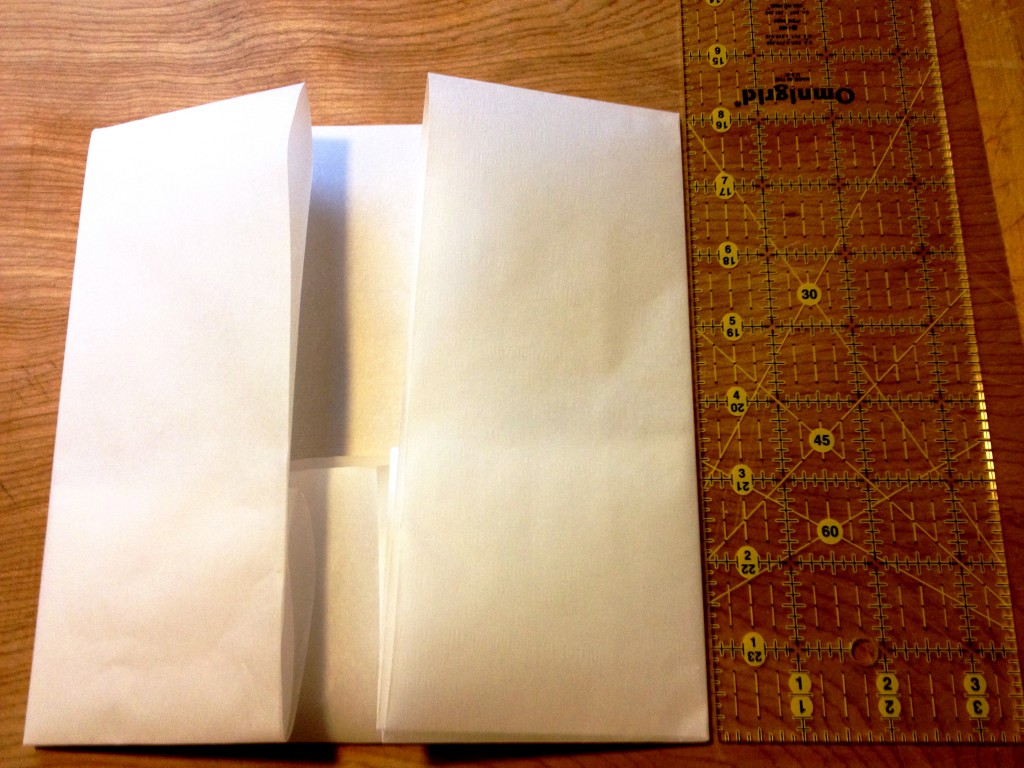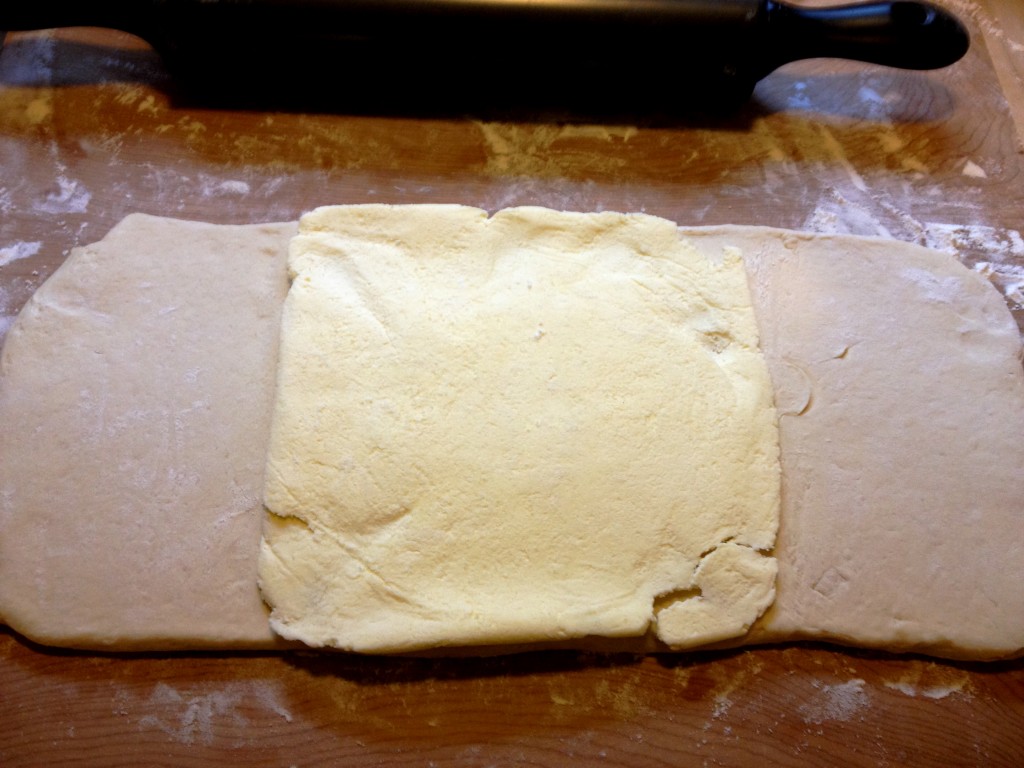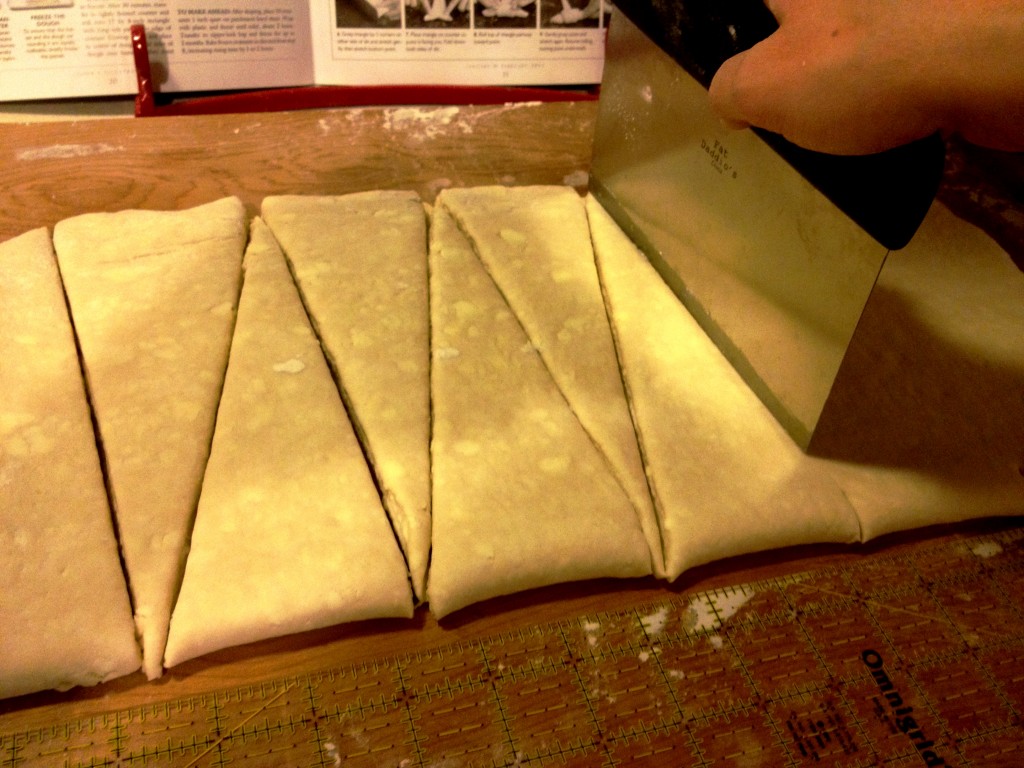Project: Croissants
Last change for fat and delicious pastries before the New Year diet season! Croissants are a perfect project for lounging around the house on the last weekend of 2012. Just imagine waking up to fresh croissants on News Years Day… add coffee (and eggs and bacon) for a excellent hangover cure.
I have loved croissants since I was a small child. My mom would take me shopping at Washington Square where they used to have a little booth that sold pastries. I don’t remember anything else about it, except that they sold hams and cheese croissants. Hot. So good and so greasy.
Then I married a man who loves them just as much, perhaps more than I do. He has been known to put away an entire box of them at breakfast. Sometimes we call them french donuts (movie reference, can you name it?). With all this croissant love, it’s only natural that I try to make them.
This is my second attempt. The first time, I used a recipe from Baking Illustrated via Annie’s Eats. They were excellent. Perfect flavor, flakiness, lots of layers, but after an entire day of work, I had 12 rolls. We ate them in 24 hours (don’t judge) and then they were gone. Seemed like a lot of work for just a small amount of reward.
This time, I used a recipe from Cooks Illustrated (I thought Cook’s was the same as Baker’s Illustrated but the recipes are different, so I don’t know) that makes 22 rolls and has instructions for freezing at least half of them, which forces us to enjoy them at a slower pace. I baked 6 right away, 8 on Christmas morning, and now we have 8 more to eat over the next few weekends.
There are two important things to know about making croissants. One, you will use more than 3 sticks of butter. That’s what makes them delicious, but it’s also what made me feel like a grease ball by the end of the day. Two, it takes AT LEAST 10 hours from start to finish, but it took me 12, so plan on staying home ALL DAY.
Here is the basic process: you make a yeast dough and a butter block. A butter block is exactly what it sounds like, you beat butter with a rolling pin until soft, then shape it into a square. Roll out the dough, then wrap it around the butter. Then start rolling. Roll out the dough/butter block, then fold it back on itself. Roll again. Fold again. You do that a few times, then roll it out, cut it into triangles and shape into croissants.
A couple of notes: First, the recipe suggests using King Arthur All-puropose flour, because it has an ideal gluten content. I used regular all-purpose, but if you have it or want to splurge a little, give King Arthur a try. Second, they suggest European-style butter (whatever that is). I got mine at Whole Foods. $6 a pound. Third, as you will see in the photos, I used a ruler a LOT during this process. I normally use it for quilting, but it worked perfectly for baking.
Here’s the recipe. Brace yourself, it’s a long one.
CROISSANTS
Makes 22
From Cook’s Illustrated January/February 2012
3 Tbsp. unsalted butter, plus 24 Tablespoons (3 sticks) unsalted European-style butter, very cold
1 3/4 cups whole milk
4 tsp. instant or rapid rise yeast
4 1/4 cups flour
1/4 cup sugar
salt
1 large egg
1 teaspoon cold water
1) Melt 3 tablespoons of butter in medium saucepan over low heat. Remove from heat and immediatly stir in milk (temperture should be lower than 90 degrees). Whisk in yeast; transfer milk mixture to bowl of stand mixer. Add flour, sugar and 2 teaspoons of salt. Using dough hook knead on low speed until cohesive dough forms, 2 to 3 minutes. Increase speed to medium-low and knead for 1 minute. Remove bowl from mixer and cover with plastic wrap Let dough rest at room temperture for 30 mintues.
2) Transfer dough to parchment paper-lined baking sheet and shape into 10×7 inch rectagle about 1 inch thick. Wrap tightly with plastic and refridgerate for 2 hours.
3) BUTTER BLOCK: While dough chills, fold a 24 inch length of parchment in half to create 12-inch rectangle. Fold over the 3 open sides of the the rectangle to form an 8-inch square with enclosed sides. Crease folds firmly. Place 24 tablespoons cold butter directly on counter and beat with a rolling pin for about 60 seconds until the butter is just pliable but not warm. Then fold butter in on itself using a scraper. Beat into a rough 8-inch square. Unfold the parchment envelope. Using the scraper, transfer butter to center of parchment, refolding at creases to enclose. Turn packet over so the flaps are underneath and gently roll until butter fills the parchment square, taking care to achieve and even thickness. Refrigerate at least 45 minutes.
4) LAMINATE: Transfer dough to freezer. After 30 minutes, transfer to lightly floured counter and roll in to a 17 x 8 inch rectangle with long side parallel to edge of counter. Unwrap butter and place it in center of the dough. Fold sides of dough over butter so they meet in center. Press seams together with fingertips. With rolling pin, press firmly on each open end of packet. Roll out lengthwise into 24×8 inch rectangle. Starting at bottom of the dough, fold into thirds like a business letter, into an 8-inch square. Turn dough 90 degrees counter clockwise. Roll out lengthwise again into 24×8 inch rectangle and fold into thirds. Place dough on sheet, wrap tightly with plastic and return to freezer for 30 minutes.
5) Transfer dough to lightly floured counter so that top flap opens on the right. Roll out dough lengthwise into 24×8 inch rectangle and fold into thirds. Place dough on sheet wrap tightly with plastic and refrigerate for 2 hours or up to 24 hours.
6) SHAPE: Transfer dough to freezer. After 30 minutes, transfer to lightly floured counter and roll into 18 x 16 inch rectangle with long side of rectangle parallel to edge of counter. Fold upper half of dough over lower half. Using ruler, mark dough at 3-inch intervals along the bottom edge with a scraper (you should have 5 marks). Move ruler to top edge of dough, measure 1.5 inches from left, then use this mark to measure out 3-inch intervals (you should have 6 marks). Starting at lower left corner, use a pizza wheel, knife or scraper to cut from mark to mark. You will have 12 triangles, 5 diamonds; discard scraps. Unfold diamonds and cut into 10 triangles (making 22 triangles total).
7) Position one triangle on counter. (Keep remaining triangles covered in plastic). Cut 1/2 inch slit in center of short side of triangle. Grasp triangle by two corners on either side of slit and stretch gently, then stretch bottom point. Place triangle on counter so point is facing you. Fold down both sides of slit. Roll top of triangle partway towards point. Gently grasp point with one hand a stretch again. Resume rolling, tucking point underneath. Curve ends gently towards each other to create crescent. Repeat with remaining triangles.
8) Place 12 croissants on 2 parchment-lined sheets at least 2.5 inches apart. Lightly wrap with plastic. Let stand at room temperature until nearly doubled in size, 2.5 to 3 hours. (Shaped croissants can be refrigerated for up to 18 hours. Remove from refrigerator to rise and add 30 minutes to rising time.)
9) After croissants have risen for two hours, adjust oven racks to upper-middle and lower middle positions and heat oven to 425. In small bowl, whisk together egg, water and a pinch of salt. Brush croissants with egg wash. Place croissants in oven and lower temperature to 400 degrees. Bake for 12 minutes then switch and rotate baking sheets. Continue to bake until deep golden brown, 8 to 12 minutes longer. Transfer to wire rack and cool about 15 minutes. Serve warm or at room temperature.
FREEZING INSTRUCTIONS: After step 7 place the croissants you’d like to freeze on a parchment lined sheet 1 inch apart. Wrap with plastic and freeze solid, about 2 hours. Transfer to zipper-lock bag and freeze for up to 2 months. Bake frozen croissants as directed from step 8, increasing rising time by 1 to 2 hours.















How cool! What an endeavor!! They look great.